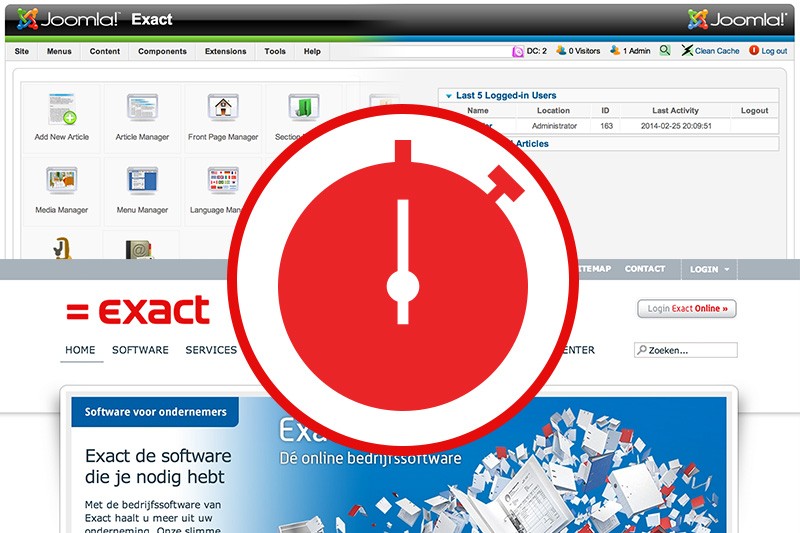Complex Joomla! 1.5 Migration With Minimal Downtime
Joomla 1.5 is not supported by the Joomla project for quite some time now. You still can continue to use Joomla 1.5, but (security) updates will no longer be released. Furthermore, both Joomla 2 and Joomla 3 have many new features and improvements. Perhaps you recognize it: once you use Joomla 2 or Joomla 3, managing a Joomla 1.5 website really feels old-fashioned and you notice how greatly Joomla actually improved.
You should really migrate Joomla 1.5 websites to a Joomla version that is currently supported by the Joomla project. Unfortunately there are still many Joomla 1.5 websites around, because of various reasons. No time, no budget, no motivation, hold off, etc..
Sometimes it’s because of the complexity of a migration. Recently a Joomla 1.5 website with complex conditions needed to be migrated. A great challenge and I would like to share the knowledge acquired to help you migrating any complex Joomla websites you might have.
Joomla website Exact Netherlands
Exact is a leading global supplier of business software and provides a complete ERP offering for small and medium-sized businesses. Exact develops industry-specific on-premise and cloud solutions for manufacturing, wholesale and distribution, professional services and accountancy. Exact is using Joomla for many of their websites for several years now. The Exact Netherlands website was powered by Joomla 1.5 and needed to be migrated.
The website is one of the largest Joomla websites in The Netherlands and the main marketing, communication and sales tool of Exact. Exact has a great importance for a stable website that is always available for its visitors. For this reason, the hosting environment is fully redundant for example.
Many content editors work on a daily basis on the website which is in constant motion. The website uses several (custom) extensions and contains a large number of menu items, articles and modules.
Strong requirements for the migration
For the migration strong requirements were made: migrate the website within 1,5 day and two hours was the maximum downtime allowed during the evening hours. The expected result was a website with identical layout, functionality, URLs, menus, articles, etc. but powered by Joomla 2.5. In short: the visitor should not see or experience differences between the Joomla 1.5 and Joomla 2.5 version of the website.
But how do you achieve that? A “typical” Joomla migration (make a copy, migrate it, correct settings and put it online) was not an option for Exact. This would take too long and the copy of the website in migration would be outdated within hours.
Typical Joomla Migration
To get a good overview of the migration the project started with the typical migration. To migrate the Joomla core data I prefer to use the extension SP Upgrade. This paid extension is installed in a fresh Joomla 2.5 installation without sample data. All 1500 articles, 650 menu items, and 950 modules were imported by using this extension.
The website uses several third party extensions, fortunately all with a Joomla 2.5 version available. These extensions were migrated by copying the database tables to the Joomla 2.5 database, something that can be done with SP Upgrade as well, and then install the extensions. The extensions will detect outdated database structures and update them if needed. For the template, a Joomla 2.5 version was already available.
New features, new settings
Until now all steps are part of a typical Joomla migration. The website data is now migrated, but when checking the website you will notice that it does not look as it should yet. This is often caused by different or new settings in Joomla compared to older Joomla versions. A typical example is the Joomla menu module. In Joomla 1.5 you configured to display level 0 to 3, in Joomla 2.5 you need to configure level 1 to 4 to achieve the same output. Level 0 does not exist anymore in Joomla 2.5.
Normally you check all these settings and make adjustments where necessary. Depending on the size of the website this may take hours or even days. Once everything is checked and adjusted, the website is ready put live. This part of the migration was the main problem for Exact, it would take way to long to adjust all settings and it is too unpredictable.
A custom migration script
Still it must be clear which data and setting adjustments were needed to ensure that the Joomla 2.5 version would be identical to the Joomla 1.5 version. Instead of making changes through the interface of Joomla, the changes where made directly in the database, while keeping track of these changes.
All these changes have been incorporated into a customized script that consists out of a set of SQL queries. Collecting all these necessary adjustments will take time, but once the script is completed, the SQL queries are executed in seconds.
Menu level changes
Let's create a simple custom migration script and use the module level setting adjustments as an example. Create a file called “migrate.php” and place that in the root of the website. Add the code below in that file. The code will change modules with ID’s 233, 294 and 357. The parameters of these modules are modified in a loop, and after that saved in the database. The “startLevel” of module with ID 233 is changed from “2” to “3”. As additional examples the “menutype” is added for module with ID 294 and the “You are here” text is set to “hide” for the breadcrumbs module with ID 357.
define('_JEXEC', 1);
// Connect with Joomla
define('JPATH_BASE', __DIR__);
require_once JPATH_BASE . '/includes/defines.php';
require_once JPATH_BASE . '/includes/framework.php';
// Database connection
$db = JFactory::getDBO();
/**
* Module changes
*/
// Get the modules that need changes
$query = $db->getQuery(true);
$query->select('*')
->from('#__modules')
->where('id IN (233,294,357)');
$db->setQuery($query);
$modules = $db->loadObjectList('id');
foreach($modules as $module)
{
$module->params = json_decode($module->params);
}
// Change startLevel
if ($modules[233]->params->startLevel == 2)
{
$modules[233]->params->startLevel = 3;
echo('Module [233]: startLevel: 3
');
}
// Set menutype
if (empty($modules[294]->params->menutype))
{
$modules[294]->params->menutype = 'mainmenu';
echo('Module [294]: menutype: mainmenu
');
}
// Hide breadcrumb "You are here"
if (!$modules[357]->params->showHere)
{
$modules[357]->params->showHere = 0;
echo('Module [357]: showHere: 0
');
}
// Save new module params
foreach($modules as $id=>$module)
{
$params = json_encode($module->params);
$mod = new JObject();
$mod->id = $id;
$mod->params = $params;
$result = $db->updateObject('#__modules', $mod, 'id');
}
Full script as Gist: https://gist.github.com/sanderpotjer/9311435
Extension specific changes
Similar to this adjustments can be made anywhere in the database. For the extension ZOO all items needed adjustments for the access setting. Because of the migrations the items were not visible anymore, which is obviously not the intention. You can add the following code to the migration script to ensure that the access for the ZOO items is corrected in the database.
/**
* Component changes
*/
// ZOO access fixes
$query = $db->getQuery(true);
$fields = array('access=1');
$conditions = array('access=0');
$query->update($db->quoteName('#__zoo_item'))->set($fields)->where($conditions);
$db->setQuery($query);
$result = $db->query();
echo('ZOO: Access set to 1
');
Full script as Gist: https://gist.github.com/sanderpotjer/9311435
Drastically reduce migration time
You can probably imagine that the script eventually used for the Exact migration is many times bigger, but above gives you an idea about the power of a custom migration script: all actions that you would normally perform for a migration in the Joomla backend are done in just seconds, instead of hours or days. This drastically reduces the time needed for the migration, something we could really use for the migration of the Exact Netherlands website.
An additional advantage of the migration script is that you can test and improve the migration repeatedly until the desired result is achieved.
Joomla 2.5 base
In addition to database changes it is often necessary to make server files changes, such as template overrides. This is done during the testing process as well and resulted in a Joomla 2.5 base installation that included all files necessary for the final Joomla 2.5 version of the website.
For extensive testing of the custom migration script each time a fresh copy of the Joomla 2.5 base installation is used. In this way the migration is well prepared and unexpected surprises during the final migration are eliminated.
The big migration day
After weeks of preparations we were ready for the final migration day. Several last test migrations were made and the Joomla 2.5 base installation was prepared in a subfolder of the domain. Everything was ready to for the final migration of the website, for which we used the following steps:
- Back-up Joomla 1.5 website
- Take Exact.nl (Joomla 1.5) website offline
- Migration of the Joomla core data by SP Upgrade (+/- 1 minute)
- Copy extension tables to the Joomla 2.5 database (+/- 1 minute)
- Operations in the Joomla 2.5 website (+/- 2 minutes)
- Installation of 3rd party extensions
- Execute upgrade scripts of 3rd party extensions
- Start indexing content by Joomla Smart Search
- Solve asset issues with ACL Manager
- Execute custom migration script (+/- 0,5 minute)
- Move Joomla 1.5 website files to archive folder (+/- 0,5 minute)
- Move Joomla 2.5 website files to website root (+/- 0,5 minute)
- Change the /tmp/ en /log/ paths in configuration.php, and delete the custom migration script from server (+/- 0,5 minuut)
- Put Exact.nl (Joomla 2.5) website back online
Successful Joomla migration in six minutes
As you can see the Exact Netherlands website was down for just six minutes. During this downtime the the entire website with all its data was migrated from Joomla 1.5 to Joomla 2.5.
Visitors noticed no difference, forms submissions from minutes before the downtime were processed and migrated successfully. Content editors that made changes in the Joomla 1.5 website earlier that day saw a renewed Joomla administrator after login, but found all changes back in the migrated website. No data was lost.
The successful migration with the very short downtime needed to be celebrated. For that we enjoyed the one and only freshly baked Joomla Stroopwafels!

A couple migration take-aways
- Clean up: make sure the website is completely cleaned up, Remove articles, categories, modules and menus that are no longer in use and empty the trash before the migration.
- Backup, and test backup: always make a backup of the website and test if restoring the backup is working correctly.
- Test, test, test and test: I’m sure you won’t like surprises during a migration. Know what to expect, always test a migration before migrating a live website.
- Emergency revert: make sure you can always put back the old version of the website at any moment during the migration.
- Don’t hold off: migrate your non-supported Joomla websites now. Joomla 2.5 and Joomla 3.2 are the versions currently supported by the Joomla project. They are safe, stable and have loads of great new features and improvements.
Some articles published on the Joomla Community Magazine represent the personal opinion or experience of the Author on the specific topic and might not be aligned to the official position of the Joomla Project
By accepting you will be accessing a service provided by a third-party external to https://magazine.joomla.org/
 Community Magazine
Community Magazine 
Comments